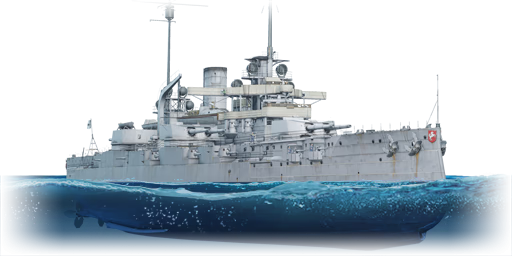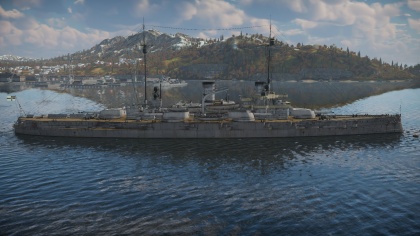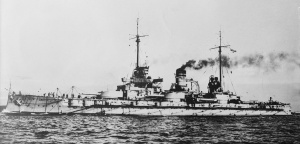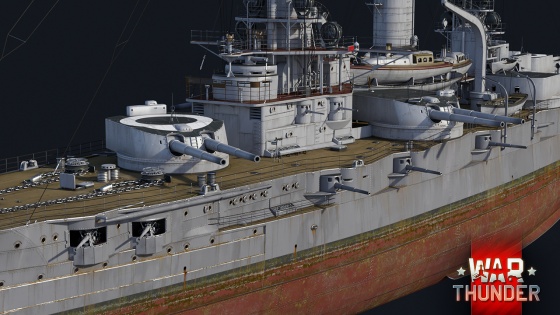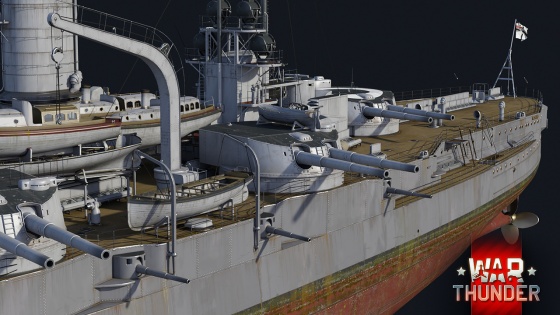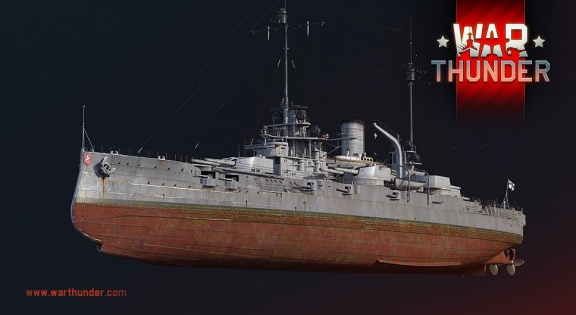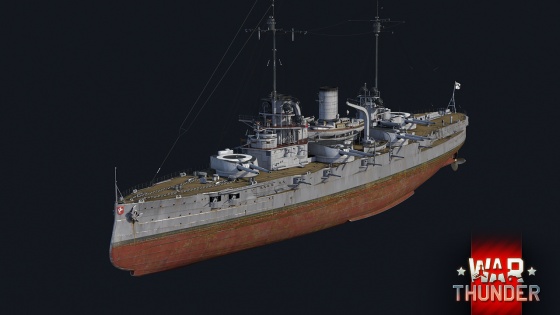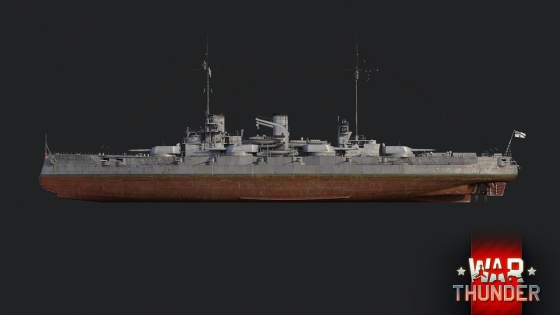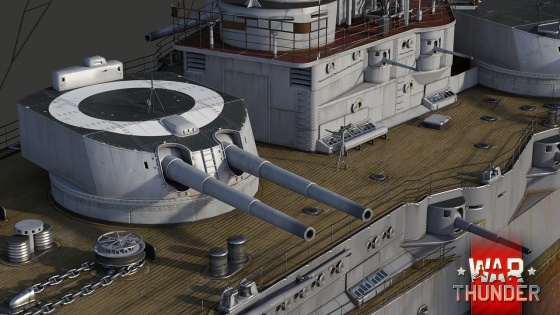SMS Westfalen
Contents
Description
The Nassau-class, SMS Westfalen, 1916 is a rank V German battleship
with a battle rating of 6.3 (AB/RB/SB). It was introduced in Update "New Power".
General info
Survivability and armour
Talk about the vehicle's armour. Note the most well-defended and most vulnerable zones, e.g. the ammo magazine. Evaluate the composition of components and assemblies responsible for movement and manoeuvrability. Evaluate the survivability of the primary and secondary armaments separately. Don't forget to mention the size of the crew, which plays an important role in fleet mechanics. Save tips on preserving survivability for the "Usage in battles" section. If necessary, use a graphical template to show the most well-protected or most vulnerable points in the armour.
Mobility
Write about the ship's mobility. Evaluate its power and manoeuvrability, rudder rerouting speed, stopping speed at full tilt, with its maximum forward and reverse speed.
| Mobility Characteristics | |||
|---|---|---|---|
| Game Mode | Upgrade Status | Maximum Speed (km/h) | |
| Forward | Reverse | ||
| AB | |||
| Upgraded | 44 | 25 | |
| RB/SB | |||
| Upgraded | 37 | 22 | |
Armament
Primary armament
Provide information about the characteristics of the primary armament. Evaluate their efficacy in battle based on their reload speed, ballistics and the capacity of their shells. Add a link to the main article about the weapon: {{main|Weapon name (calibre)}}. Broadly describe the ammunition available for the primary armament, and provide recommendations on how to use it and which ammunition to choose.
Secondary armament
Some ships are fitted with weapons of various calibres. Secondary armaments are defined as weapons chosen with the control Select secondary weapon. Evaluate the secondary armaments and give advice on how to use them. Describe the ammunition available for the secondary armament. Provide recommendations on how to use them and which ammunition to choose. Remember that any anti-air armament, even heavy calibre weapons, belong in the next section. If there is no secondary armament, remove this section.
Anti-aircraft armament
An important part of the ship's armament responsible for air defence. Anti-aircraft armament is defined by the weapon chosen with the control Select anti-aircraft weapons. Talk about the ship's anti-air cannons and machine guns, the number of guns and their positions, their effective range, and about their overall effectiveness – including against surface targets. If there are no anti-aircraft armaments, remove this section.
Usage in battles
Describe the technique of using this ship, the characteristics of her use in a team and tips on strategy. Abstain from writing an entire guide – don't try to provide a single point of view, but give the reader food for thought. Talk about the most dangerous opponents for this vehicle and provide recommendations on fighting them. If necessary, note the specifics of playing with this vehicle in various modes (AB, RB, SB).
Modules
| Tier | Seakeeping | Unsinkability | Firepower | ||
|---|---|---|---|---|---|
| I | Dry-Docking | Tool Set | Anti-Air Armament Targeting | 283 mm Psgr. L/3.2 | |
| II | Rudder Replacement | Fire Protection System | Auxiliary Armament Targeting | 150 mm Sprgr. L/3.2 Bdz | |
| III | Propeller Replacement | Shrapnel Protection | Ventilation | Primary Armament Targeting | Improved Rangefinder |
| IV | Engine Maintenance | New Pumps | Ammo Wetting | ||
Pros and cons
Pros:
- Lots of firepower available from guns
- Can use torpedoes
- Very hard to defeat
Cons:
- Somewhat weaker main guns in comparison to other battleships
- Mediocre anti-air defense, only totes rifle-caliber machine guns that are useless against any aircraft more armored than starting planes and two heavy cannons that cannot engage multiple targets due to their slow fire rate
- Huge profile and low mobility
History
SMS Westfalen was a member of the four-ship Nassau-class, the first class of dreadnoughts built by the Imperial German Navy. Commissioned in 1909, she saw extensive service during the First World War, where she participated in many naval engagements. She was also responsible for the destruction of three British destroyers at the Battle of Jutland. Westfalen was damaged in 1918, and thereafter used as a training ship; she was later handed to the United Kingdom as a war reparation, and scrapped in 1924.[1]
Design and construction
The Nassau class was built to counter the British HMS Dreadnought, who had revolutionized modern battleship design. As a result, the Nassaus were the first ships of the German Navy to carry an all-big-gun armament. The ships were also the first German vessels to be equipped with a torpedo bulkhead.[1] The ships were intended to carry new steam turbines, but the German steam-turbine manufacturing process had not been refined; as a result, the Nassaus were equipped with large, space-consuming piston engines.[1] This also contributed to the installation of Westfalen's unique hexagonal main armament arrangement.[1] Westfalen was launched on July 1st 1908, and commissioned in November of 1909.
Westfalen displaced just over 20 thousand tons, and was capable of making just over 20 knots. She carried a main armament of twelve 11-inch (281 mm) guns in a hexagonal formation, with four guns mounted on the beam.[1] She also carried a large amount of 5.9-inch (150 mm) and 88 mm guns to counter smaller vessels and torpedo boats.[1] Later on, Westfalen was refitted to carry a small number of anti-aircraft guns; she initially carried six underwater torpedo tubes, but these were later removed.1[1]
Service History
After her commissioning, the SMS Westfalen served as the flagship of the First Battle Squadron, replacing the elderly pre-dreadnought SMS Kaiser Barbarossa.[1] She served in this role until 1914, when she was slated to be moved to the Second Battle Squadron; however, these plans were put on hold following the outbreak of the First World War.[1] She then served as part of the screening force protecting Admiral Hipper's battlecruisers, which were shelling the towns of Scarborough, Hartlepool and Whitby.[1] She also served a minor role in the Battle of the Gulf of Riga.[1]
Westfalen participated in the Battle of Jutland, where she was at the rear of the German Battleship Formation. However, in the late evening, she encountered a light force of several British destroyers, and an ensuing firefight erupted at close range.[1] Westfalen scored several hits on the British destroyer leader Tiperrary, causing critical damage;[1] the destroyer was later finished off by her sister ship Nassau. She then fired multiple salvoes at the destroyers Fortune and Turbulent, critically damaging the former and sinking the latter. During this time, her bridge was hit by a round fired from a destroyer, which killed two and injured several others; the ship received no other battle damage.[1]
Following this action, the Westfalen returned to port for repairs. Several months later, she was yet again part of the screening force for Hipper's battlecruisers, this time for a raid on the town of Sunderland. However, Westfalen was struck by a torpedo from the British submarine E23,[1] which flooded her torpedo bulkhead with 800 tons of water. Despite this, the torpedo bulkhead held, demonstrating its effectiveness.[1]
In February of 1918, the ship participated in the Finland intervention by transporting troops.[1] She also fired her main guns in support of German Forces. In April, Westfalen completed this operation and returned to the First Battle Squadron; however, in August, she suffered serious damage to her boilers.[1] Thus, she was decommissioned and used as a training ship.[1] Following the conclusion of the First World War, Westfalen was handed over to the United Kingdom as a war reparation. Thus, she was scrapped in 1924 at Birkenhead.[1]
Devblog
After the incredible HMS Dreadnought appeared, German shipbuilders began working on a new battleship design to succeed the British flagship.
Several new designs were created and considered as a result, but eventually the “G7b” design was approved by the Kaiser in March 1906, officially becoming the Nassau class. Shortly after, two of the new Nassau battleships were ordered with two further ships being added to the construction queue of German shipyards later.
SMS Westfalen was the last of the Nassau-class battleships to be laid down in August 1907, but the second to be commissioned into service with the Imperial Navy in November 1909. In the years leading up to WWI, Westfalen actively took part in routine fleet exercises and training courses with other elements of the Imperial Navy.
During the war, Westfalen, along with other ships of its type, actively participated in combat. The 2nd division (all ships of the Nassau type) of the 1st Hochseeflot squadron fought in the Baltic, and then in full force at Jutland, where they were especially active during the night phase of the battle. Initially, Westfalen, Nassau and Rheinland shot the destroyer Tipperary, and after that, a collision between Nassau and the destroyer Spitfire occurred where due to the extremely short distance between ships, the destroyer was below the sector of fire of the main battery guns, but was damaged by muzzle gases and barely escaped. Westfalen rammed and sank the destroyer Turbulent, and also participated in the sinking of the destroyers Ardent and Fortune. After Jutland, she took part in Operation Albion. Following the end of WWI, Westfalen was ceded to Great Britain as a replacement for some of the German ships lost to scuttling at Scapa Flow and shortly afterwards sold for scrap, being broken up between 1920 - 1924.
Media
- SMS Westfalen Devblog Images
See also
Links to articles on the War Thunder Wiki that you think will be useful for the reader, for example:
- reference to the series of the ship;
- links to approximate analogues of other nations and research trees.
External links
Citations
Bibliography
- Militaer Wissen. (n.d.). Battleship SMS Westfalen. Retrieved November 30, 2020, from https://www.militaer-wissen.de/battleship-sms-westfalen/?lang=en
| Germany battleships | |
|---|---|
| Nassau-class | SMS Nassau · SMS Westfalen |
| Helgoland-class | SMS Helgoland · SMS Ostfriesland |
| Kaiser-class | SMS Kaiser |
| Bayern-class | SMS Bayern · SMS Baden · SMS Sachsen |


